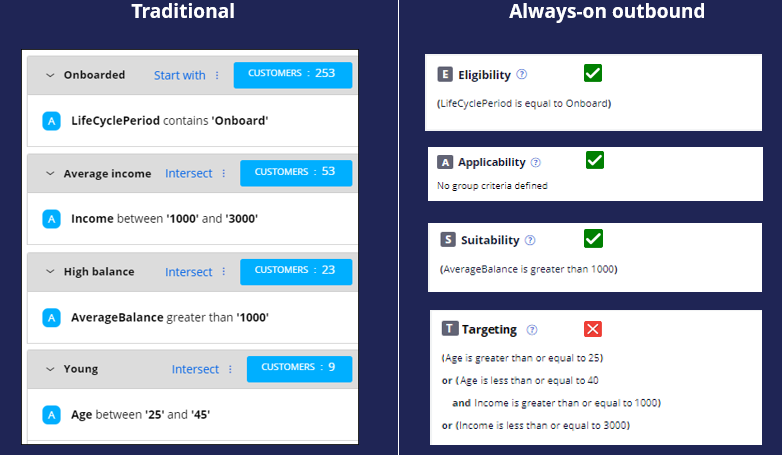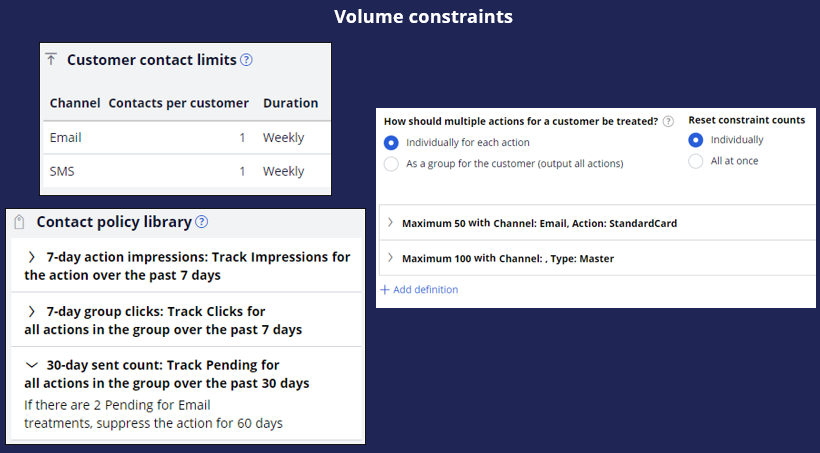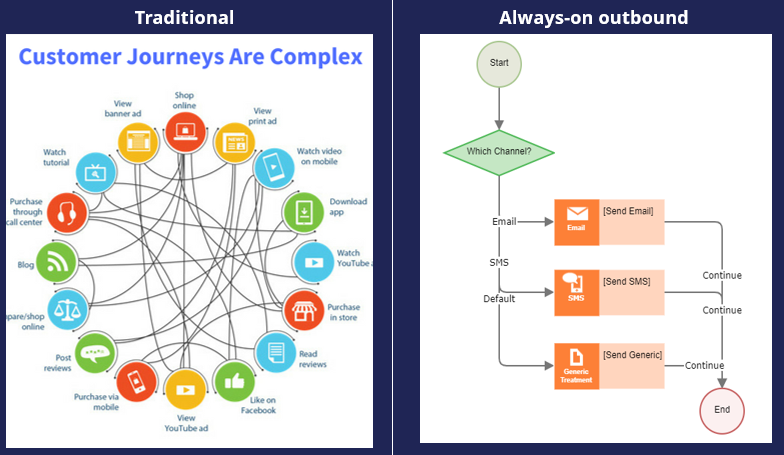
Traditional marketing versus always-on outbound
Overview
As more organizations switch from traditional marketing approaches to 1:1 customer engagement, there is a need to compare and contrast the terminologies used in the two approaches.
Here are some key terminologies and concepts used in traditional marketing, translated into concepts in the always-on, Next-Best-Action approach.
Marketing campaigns and programs
In traditional marketing, a marketing program is a set of activities designed to meet marketing objectives by grouping campaigns into logical business outcomes.
In the always-on approach, marketing programs translate into hierarchies of Issues and Groups. You can use your existing marketing objectives and desired outcomes to define the Issue/Group hierarchies that best meet your needs.
For example, a marketing program could be designed to address the business objective of decreasing dormancy in credit card usage. In this case, you would design a series of marketing campaigns that target infrequent credit card users, encouraging them to use their cards with various offers such as additional bonus points or discounts. In the always-on approach, this translates into defining the Issue as, in this case, Dormancy, and the Group as Promotions. Under this group, you would then create actions called 10% additional bonus points, or 5% discount, and so on.
As a marketing operations person, you receive campaign briefs, which are documents you can use to create Actions.
A campaign translates into an action or a set of actions delivered to qualified customers. In the always-on approach, you put an action into or out of play by changing its availability setting. The advantage in the always-on approach is that any adjustment to an action will propagate across all Issues and Groups, which means that you are optimizing across all programs and campaigns at once.
Segmentation
Traditionally, you would use the term segment, audience, or population interchangeably to refer to the target audience of a Campaign, and you would define granular criteria to identify this audience.
In the always-on approach, audience segmentation translates into engagement policies combined with Artificial Intelligence (AI).
By understanding the purpose of traditional segments, you can translate them into eligibility, applicability, suitability and contact policy rules.
When selecting targets, any criteria that are not based on clear business rules should be avoided. For example, targeting a specific demographic such as an age range or income level based on market research or intuition is not necessary. In the always-on approach, it’s the job of the AI to choose the right action for each customer, once all disqualified actions are filtered out.
In the above example, the lifecycle period criterion is translated into an eligibility condition as it is a definite requirement of the business. The Average balance criterion is translated into a suitability condition as the business thinks the group of actions will be appropriate for customers who have such a balance. However, targeting an age range or income-based demographic are not clear business requirements. These conditions in the traditional approach are coming more from intuition and some offline analysis. Therefore, in the new always-on outbound approach, these conditions are not part of engagement conditions but are left to the AI. The AI will take care of finding the right customer segments that are more likely to have a positive response to the configured offers.
Segments, in the new approach, are used only to identify the starting population for an always-on outbound schedule (a multi-level campaign which initiates outbound actions). The starting population contains the list of potential customers to whom you want to send messages. For example, the starting population could be all customers who have opted in to receive promotional messages.
Segmentation reports
Traditionally, you might have used segments to generate reports on customers who match specific criteria.
In the always-on approach, you use reports generated by the simulation facility in Next-Best-Action Designer to:
- Understand customer counts.
- Validate the effect of changes to engagement policies and AI controls.
- Visualize the action mix.
Volume caps
When dealing with any form of outbound communication, there is a need to limit the number of communications both on a per-customer basis and in terms of total messages generated by the system over a given time period.
In the always-on approach, you use volume constraints, contact limits and suppression rules to set caps on communications.
Scheduling
In a traditional marketing approach, there are several options to control the campaign schedule. For example, you can run a campaign as a one-off, or as recurring daily, weekly or monthly.
In the always-on approach:
- The schedule is always-on, it runs at a set frequency, for example on a daily basis.
- Actions are marked as in or out of play using the action ‘availability’ option.
- Emergency schedules can be set-up as secondary schedules.
- Contact policies help prevent communication fatigue in customers.
Journey guidance
Traditional campaign journeys can be long and complex. They are designed as deterministic journeys in which one campaign triggers the next, which triggers a third, and so on.
The always-on approach turns managing complex journeys into managing experiences:
- Logic in the channels should be minimized to focus on the overall experience. The number of steps involved in outbound communication, represented by action flow shapes, should be limited to 2 or 3 per channel.
- Next-Best-Action combines many actions to optimize experiences. Let the Pega brain decide the next step.
- Action flows shouldn’t contain decision logic (that’s in the brain) and should not try to adapt to customer or business changes.
- Use business hierarchies (Issues/Groups) to organize the business outcomes and actions that collectively make up experiences.
This Topic is available in the following Modules:
If you are having problems with your training, please review the Pega Academy Support FAQs.
Want to help us improve this content?




